Related Research Articles

Hillbilly Hare is a 1950 Warner Bros. Merrie Melodies cartoon directed by Robert McKimson. The short was released on August 12, 1950 and stars Bugs Bunny.

Hare Brush is a 1955 Warner Bros. Merrie Melodies animated short directed by Friz Freleng. The short was released on May 7, 1955, and stars Bugs Bunny and Elmer Fudd.

False Hare is a 1964 Warner Bros. Looney Tunes animated short directed by Robert McKimson. The short was released on July 18, 1964, and stars Bugs Bunny.

Hair-Raising Hare is a Warner Bros. Merrie Melodies cartoon, released on May 25, 1946. It was directed by Chuck Jones and written by Tedd Pierce. It stars Bugs Bunny and features the first appearance of Chuck Jones' orange monster character "Gossamer".
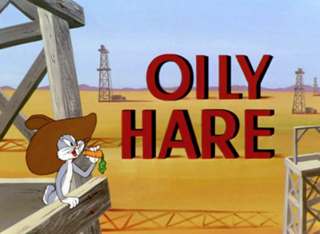
Oily Hare is a 1952 Warner Bros. Merrie Melodies animated short directed by Robert McKimson and written by Tedd Pierce. The short was released on July 26, 1952, and stars Bugs Bunny.

Herr Meets Hare is a 1945 anti-Nazi Merrie Melodies cartoon directed by Friz Freleng. The short was released on January 13, 1945, and features Bugs Bunny. This short, released not long before the collapse of the Third Reich, was the penultimate wartime themed cartoon from Warner Bros. being released just under four months before Victory in Europe Day.

Hare Force is a 1944 Warner Bros. cartoon in the Merrie Melodies series, directed by Friz Freleng. The cartoon was released on July 22, 1944, and stars Bugs Bunny.
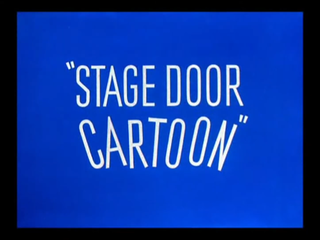
Stage Door Cartoon is a 1944 Merrie Melodies cartoon directed by Friz Freleng. The short was released on December 30, 1944, and features Bugs Bunny and Elmer Fudd.
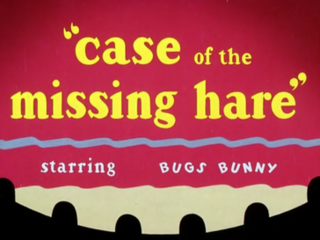
Case of the Missing Hare is a 1942 Warner Bros. cartoon in the Merrie Melodies series, directed by Chuck Jones and starring Bugs Bunny. The short was released on December 12, 1942.
The Unruly Hare is a 1945 Warner Bros. cartoon in the Merrie Melodies series directed by Frank Tashlin and written by Melvin Millar. The cartoon was released on February 10, 1945 and stars Bugs Bunny and Elmer Fudd. The film was one of only two Bugs Bunny cartoons directed by Frank Tashlin at Warner Bros., the other being 1946's Hare Remover.
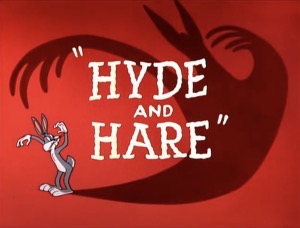
Hyde and Hare is a 1955 Warner Bros. Looney Tunes cartoon, directed by Friz Freleng. The short was released on August 27, 1955, and stars Bugs Bunny. The short is based on Robert Louis Stevenson's 1886 novella Strange Case of Dr Jekyll and Mr Hyde. The cartoon pits Bugs against Dr. Jekyll, who continues to turn into Mr. Hyde. The title is a play on the expression "neither hide nor hair."

14 Carrot Rabbit is a 1952 Warner Bros. Looney Tunes animated cartoon short directed by Friz Freleng. The short was released on March 15, 1952, and features Bugs Bunny and Yosemite Sam. The title is a play on "14 karat", as in a purity level for gold.

Buckaroo Bugs is a 1944 American Western Looney Tunes cartoon film directed by Bob Clampett. The cartoon was released on August 26, 1944, and features Bugs Bunny in his official Looney Tunes debut.
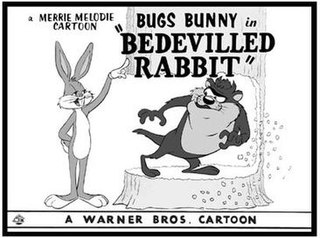
Bedevilled Rabbit is a 1957 Warner Bros. Merrie Melodies short directed by Robert McKimson. The short was released on April 13, 1957, and stars Bugs Bunny. In this cartoon, Bugs is lost in Tasmania, and has to deal with the Tasmanian Devil.
Hare-Way to the Stars is a 1958 American animated science fiction comedy short film directed by Chuck Jones and written by Michael Maltese. The short was released by Warner Bros. Pictures on March 29, 1958 as part of the Looney Tunes series, and stars Bugs Bunny and Marvin the Martian. The title is a play on the song "Stairway to the Stars."

To Hare is Human is a 1956 Warner Bros. Merrie Melodies cartoon directed by Chuck Jones. The short was released on December 15, 1956, and stars Bugs Bunny and Wile E. Coyote. In this film, Wile builds a UNIVAC computer, and grows to rely on its answers.

The Grey Hounded Hare is a 1949 Looney Tunes short film made by Warner Bros. Pictures and starring the voice talent of Mel Blanc. The film stars Bugs Bunny. It was directed by Robert McKimson, and animated by John Carey, Phil DeLara, Manny Gould and Charles McKimson, with music scored by Carl Stalling. The title refers to the greyhounds of the plot as well as "hounded" meaning pestered or pursued relentlessly.

Apes of Wrath is a 1959 Warner Bros. Merrie Melodies animated short directed by Friz Freleng. The short was released on April 18, 1959, and stars Bugs Bunny. This cartoon recycles the plot from the 1948 cartoon Gorilla My Dreams. The title is a parody of John Steinbeck's novel The Grapes of Wrath.
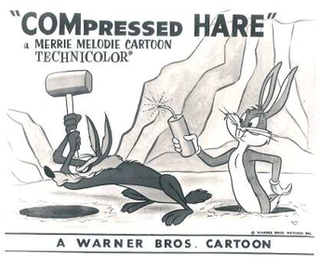
Compressed Hare is a 1961 Merrie Melodies cartoon directed by Chuck Jones and Maurice Noble. The short was released on July 29, 1961, and stars Bugs Bunny and Wile E. Coyote. This is the final first-run Golden Age short in which Wile E. Coyote speaks, although he speaks again in the Adventures of the Road Runner featurette a year later.

Bill of Hare is a 1962 Warner Bros. Merrie Melodies cartoon directed by Robert McKimson. The short was released on June 9, 1962, and stars Bugs Bunny and the Tasmanian Devil.
References
- ↑ Beck, Jerry; Friedwald, Will (1989). Looney Tunes and Merrie Melodies: A Complete Illustrated Guide to the Warner Bros. Cartoons. Henry Holt and Co. p. 188. ISBN 0-8050-0894-2.
- ↑ Lenburg, Jeff (1999). The Encyclopedia of Animated Cartoons . Checkmark Books. pp. 60-61. ISBN 0-8160-3831-7 . Retrieved 6 June 2020.